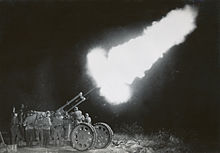Karlsborg Artillery Regiment
58°31′52.6″N 14°31′47.2″E / 58.531278°N 14.529778°E
| Karlsborg Artillery Regiment | |
|---|---|
| Karlsborgs artilleriregemente | |
| Active | 1920–1937 |
| Country | |
| Allegiance | Swedish Armed Forces |
| Branch | Swedish Army |
| Type | Artillery |
| Size | Regiment |
| Part of | III Army Division (1920–1927) Western Army Division (1928–1936) III Army Division (1937–1937) |
| Garrison/HQ | Karlsborg |
| Colors | Dark blue |
| March | "Till fronten" (Rydberg)[note 1] |
Karlsborg Artillery Regiment (Swedish: Karlsborgs artilleriregemente), designation A 9, was a Swedish Army artillery unit which operated between 1920 and 1937. The unit was based in Karlsborg Garrison in Karlsborg, Sweden.
History[edit]

Karlsborg Artillery Regiment originate from Boden-Karlsborg Artillery Regiment (A 8), which was divided into two parts on 1 January 1920; Boden Artillery Regiment (A 8) and Karlsborg Artillery Corps (A 10).[2] In 1921, the first attempts were made with anti-aircraft warfare within the Swedish Army. Through the Defence Act of 1925, it was stated that the searchlight formations and the air defense artillery were to be transferred to the artillery from the Swedish Engineer Troops, and that Karlsborg Artillery Corps would thereby form an air defense artillery regiment.[3]
From 1 January 1928, the artillery corps was reorganized into an artillery regiment. Thus, the new name Karlsborg Artillery Regiment (A 9) was adopted.[2] The regiment thus took over the designation from the Position Artillery Regiment (Positionsartilleriregementet), which was amalgamated with Småland Artillery Regiment (A 6).[4]
Karlsborg Artillery Regiment was not only a leading unit in the development of Swedish air defense, but also the unit that all Swedish air defense units were developed from. On 1 July 1937, the air defense was given an independent position within the artillery. Thus, Karlsborg Artillery Regiment was reorganized into an air defense regiment called Karlsborg Anti-Aircraft Regiment.[5]
Barracks and training areas[edit]

Karlsborg Artillery Regiment was located at Karlsborg Fortress. The installation was taken over by Karlsborg Air Defense Regiment. In 1961, the installation was taken over within the fortress by the Göta Signal Regiment (S 2).[6] Since 1984, the Life Regiment Hussars (K 3) are housed in the fortress.
Heraldry and traditions[edit]
Colours, standards and guidons[edit]
On 16 June 1938, His Majesty the King Gustaf V on his 80th birthday, presented a standard to the regiment at Ladugårdsgärdet. The standard was carried on by Karlsborg Air Defense Regiment until it was disbanded in 1961. The standard was carried by Göta Signal Regiment (S 2) until 1984. On 8 October 1984, the standard was carried by the Swedish Anti-Aircraft Combat School (Luftvärnsskjutskolan, LvSS).[7]
Heritage[edit]
Since 1 July 2000, the memory of Karlsborg Air Defense Regiment is preserved by the Air Defence Regiment (Lv 6).[4]
Commanding officers[edit]
- 1920–1925: Bernhard Andrén
- 1925–1933: Nils Ekelöf
- 1933–1937: Jacques de Laval
Names, designations and locations[edit]
| Name | Translation | From | To | |
|---|---|---|---|---|
| Kungl. Karlsborgs artillerikår | Royal Karlsborg Artillery Corps | 1920-01-01 | – | 1927-12-31 |
| Kungl. Karlsborgs artilleriregemente | Royal Karlsborg Artillery Regiment | 1928-01-01 | – | 1937-06-30 |
| Designation | From | To | ||
| A 10 | 1920-01-01 | – | 1927-12-31 | |
| A 9 | 1928-01-01 | – | 1937-06-30 | |
| Location | From | To | ||
| Karlsborg Garrison | 1920-01-01 | – | 1937-06-30 |
See also[edit]
Footnotes[edit]
References[edit]
Notes[edit]
- ^ Sandberg 2007, p. 65
- ^ a b Holmberg 1993, p. 30
- ^ Westrin, Fahlstedt & Söderberg 1926, p. 692
- ^ a b Braunstein 2003, pp. 225–226
- ^ Holmberg 1993, p. 31
- ^ Holmberg 1993, p. 32
- ^ "Standar m/1938 för Karlsborgs luftvärnsregemente". www.digitaltmuseum.se (in Swedish). Retrieved 14 May 2019.
Print[edit]
- Braunstein, Christian (2003). Sveriges arméförband under 1900-talet. Skrift / Statens försvarshistoriska museer, 1101-7023 ; 5 (in Swedish). Stockholm: Statens försvarshistoriska museer. ISBN 91-971584-4-5. SELIBR 8902928.
- Holmberg, Björn (1993). Arméns regementen, skolor och staber: [en uppslagsbok] : en sammanställning (in Swedish). Arvidsjaur: Svenskt militärhistoriskt bibliotek (SMB). ISBN 91-972209-0-6. SELIBR 7796532.
- Sandberg, Bo (2007). Försvarets marscher och signaler förr och nu: marscher antagna av svenska militära förband, skolor och staber samt igenkännings-, tjänstgörings- och exercissignaler (in Swedish) (New ed.). Stockholm: Militärmusiksamfundet med Svenskt marscharkiv. ISBN 978-91-631-8699-8. SELIBR 10413065.
- Westrin, Theodor; Fahlstedt, Eugène; Söderberg, Verner, eds. (1926). Nordisk familjebok: konversationslexikon och realencyklopedi (in Swedish). Vol. 38 (New, rev. and rich illusion. ed.). Stockholm: Nordisk familjeboks förl. SELIBR 8072220.
